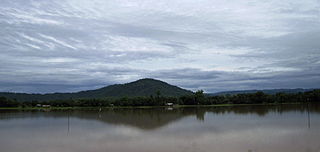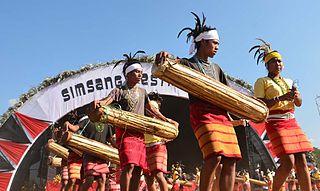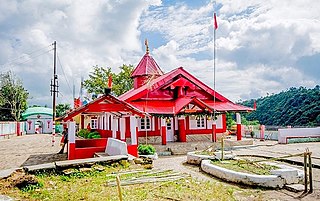
Meghalaya is a state in northeastern India. Meghalaya was formed by carving out two districts from the state of Assam: the United Khasi Hills and Jaintia Hills, and the Garo Hills on 21 January 1972. Meghalaya was previously part of Assam, but on 21 January 1972, the districts of Khasi, Garo and Jaintia Hills became the new state of Meghalaya. The population of Meghalaya as of 2014 is estimated to be 3,211,474. Meghalaya covers an area of approximately 22,430 square kilometres, with a length-to-breadth ratio of about 3:1.

Shillong is a hill station in the northeastern part of India and the capital of Meghalaya, which means "The Abode of Clouds". It is the headquarters of the East Khasi Hills district. Shillong is the 330th most populous city in India with a population of 143,229 according to the 2011 census. It is said that the rolling hills around the town reminded the British of Scotland. Hence, they would also refer to it as the "Scotland of the East".

West Garo Hills is an administrative district in Garo Hills of the state of Meghalaya in India. Tura town is the administrative headquarters of the district. The district occupies an area of 3714 km². In 2011 its population was 643,291. As of 2011 it is the second most populous district of Meghalaya, after East Khasi Hills.

Diphu (Pron:ˈdɪfu:) is the headquarter of Karbi Anglong district in the state of Assam in India. This small town is a popular tourist hill station for people of nearby cities.

Baghmara is the headquarters of South Garo Hills district in the state of Meghalaya in India. The place is bordered by Bangladesh and is about 113 km from Tura; 248 km from Guwahati; and 287 km from state capital Shillong. It has the famous river, Someshwari, also known as Simsang in Garo tribal language, flowing through its expanse and is also covered in hills and tracts along the way. This southern part of the Garo Hills region has lots of tourist spots compared to other districts and is a popular tourist destination for both domestic and international tourists when it comes to tourism in Western Meghalaya.

Williamnagar, formerly known as Simsanggre, is the headquarters of East Garo Hills district in the state of Meghalaya in India.

The Garo are a Tibeto-Burman ethnic group from the Indian subcontinent, mainly populated in the Indian state of Meghalaya and in other states like Assam, Tripura, Nagaland, and some neighboring areas of Bangladesh, notably Madhupur, Mymensingh, Netrokona, Jamalpur, Sherpur and Sylhet, Rangamati who call themselves A·chik Mande or simply A·chik or Mande - the name "Garo" being given to them and used by non-Garo. Historically, Garo name was used for wide range of inhabitants in southern bank of Brahmaputra but today, Garo means Hill tribes who call themselves A'chik Mande. They are the second-largest tribe in Meghalaya after the Khasi and comprise about a third of the local population. The Garo are one of the few remaining matrilineal societies in the world.

The Garo Hills are part of the Garo-Khasi range in Meghalaya, India. They are inhabited mainly by tribal dwellers, the majority of whom are Garo people. It is one of the wettest places in the world. The range is part of the Meghalaya subtropical forests ecoregion.

Jowai is the headquarters of the West Jaintia Hills district of the state of Meghalaya, India, and is home to the Pnar, a sub-tribe of the Khasi people. It is located on a plateau surrounded on three sides by the Myntdu river bordering Bangladesh to the south. Due to its high altitude of 1365 m above sea level, Jowai experiences warm summers with cool to chilly winters.
Marungoor, also spelt Marungur, is a panchayat town near Suchindrum in Kanniyakumari district in the Indian state of Tamil Nadu. The place sprawls over an area of about 10 km2.

Tura is a municipality in the West Garo Hills district of the Indian state of Meghalaya. One of the largest towns in Meghalaya, Tura is located in the foothills of the Tura range of the Garo Hills. Before Britishers came to Garo Hills, Tura was known as Dura and Britishers corrupted the name Dura to Tura as it was easier for them to pronounce the name. The climate in Tura is moderate throughout the year and has many interesting and unexplored areas. The native god Durama was believed to reside in the hills.
Chinnalapatti is a municipal town in Dindigul district, Tamil Nadu in India with a total population of about 26285. In 2021 most of the wards are merged to accommodate it to 18 wards, as chinnalapatti is still a town panchayat. It is understood that the number of voters are 29000 and population would be around 42000. Making it the largest town panchayat in Dindigul district. The town is well known for the handloom sarees and garments. The place is located next to Sirumalai hills which has lot of grapes farmlands.
Natham is a Taluka in Dindigul district in the Madurai Region in the Indian state of Tamil Nadu.
Sundarapandiam is a panchayat town in Srivilliputhur Taluk- old, Virudhunagar district in the Indian state of Tamil Nadu.
The indigenous people of Bangladesh refer to ethnic minorities in Chittagong Hill Tracts (southeastern), Sylhet Division (northeastern), Rajshahi Division (west), and Mymensingh Division (north-central) areas of the country. The total population of indigenous ethnic minorities in Bangladesh was estimated to be over 2 million in 2010. They are diverse ethnic communities including Tibeto-Burman, Austric and Dravidian people.

Wangala is also called the festival of "The Hundred Drums", a harvest festival celebrated by the Garo tribe, who live in Meghalaya, Nagaland and Assam in India and Greater Mymensingh in Bangladesh. In this post harvest festival, they give thanks to Misi Saljong the sun god, for blessing the people with a rich harvest. Wangala is celebrated in the months from September to December, with different villages setting different dates for the occasion.
Tiwa is an ethnic group mainly inhabiting the states of Assam and Meghalaya in northeastern India. They are also found in some areas of Arunachal Pradesh, Manipur and Nagaland. They are recognized as a Scheduled tribe within the State of Assam. They were known as Lalungs in the Assamese Buranjis and in Colonial literature and in the Constitution of India, though members of the group prefer to call themselves Tiwa. Some of their neighbours still call them Lalung.

The Hajong people are an ethnic group from Northeast India and northern parts of Bangladesh. The majority of the Hajongs are settled in India and are predominantly rice farmers. They are said to have brought wet-field cultivation to Garo Hills, where the Garo people used slash and burn method of agriculture. Hajong have the status of a Scheduled Tribe in India and they are the fourth largest tribal ethnicity in the Indian state of Meghalaya.
North Garo Hills is an administrative district in the state of Meghalaya in India. The district headquarters are located at Resubelpara. The district occupies an area of 1,113 km2 and has a population of 1,18,325.

Hinduism is a minority religion in the Meghalaya state of India constituting 12% of the state's population. The Nartiang Durga Temple in Meghalaya is one of the 51 Shakti peethas on Earth and is considered by Hindus of Meghalaya as the permanent abode of Goddess Durga. Hinduism is a popular religion practice by Rabhas, Hajongs, Kochs, Rajbongshis, Mikirs, Bengalis, Nepalis, Biharis etc.















